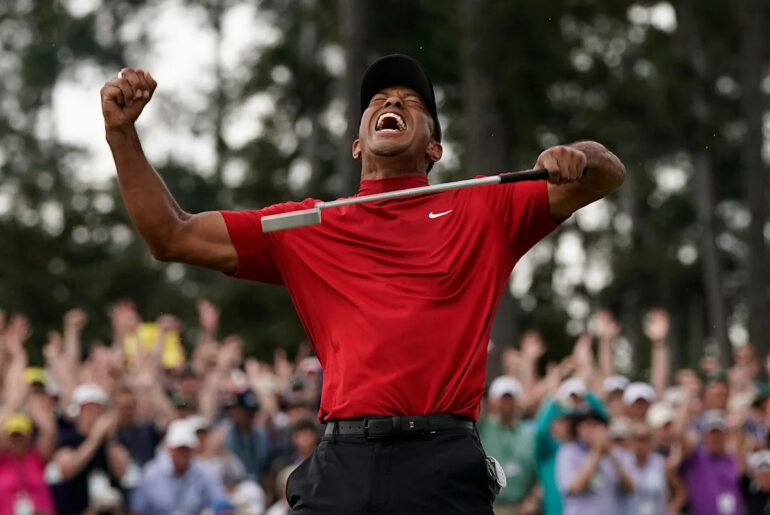What Tiger Woods JUST REVEALED About His Career Will Leave You SPEECHLESS!
It wasn’t about the wins, it was about the evolution. Those were Tiger Woods’s own words as he looked back on his 2000 season, a year that didn’t just change golf, it redefined it. Today, 25 years later, we finally have clarity on what really drove him during that stretch of untouchable greatness. What he just revealed about that legendary year will leave you absolutely speechless. And we’re only just getting started. At the dawn of the new millennium, sports were buzzing with names like Jordan, Federer, and Shoemaker. But golf, golf belonged to one man, Tiger Woods. What he accomplished in 2000 is still regarded by many as the single greatest season in golf history. And now we’re learning it was never about the trophies. He won nine PGA Tour titles, including three majors, the US Open, the Open Championship, and the PGA. His scoring average, an impossible 68.1, the lowest in PGA Tour history at the time. But even that stat sheet doesn’t tell the full story. According to Tiger himself, 2000 was the first time I felt complete. But what made him feel that way is something no one saw coming. You see, the transformation didn’t begin in 2000. It started 3 years earlier. After blowing the field away at the 1997 Masters, Tiger made the shocking decision to tear down his entire swing. Why? because he knew winning wasn’t enough if he couldn’t win forever. The world mocked it. The media doubted it. But Tiger endured two painful years in the shadows just to become unstoppable when it mattered most. 1999 was the warning shot. 2000 was the explosion. And as Tiger just confirmed in his latest sitdown with the PGA Tour, all the sacrifice, all the hours, it clicked in 2000. That was when it all came together. And you won’t believe how it all unfolded at Pebble Beach. the most dominant major win in history. And the moment Tiger broke golf itself in June of 2000, Tiger Woods didn’t just win the US Open at Pebble Beach, he obliterated the field by 15 strokes. That’s not a typo. That’s not a dramatization. It’s the largest margin of victory in major championship history. And the way it happened, almost superhuman. And Tiger just revealed something about it that changes everything we thought we knew. From the very first round, Tiger looked like he was operating on another frequency. He was the only player under par on a course that punished everyone else. He seemed untouched by wind, nerves, or gravity. By Sunday, the rest of the field wasn’t chasing the trophy. They were chasing second place. This wasn’t dominance. It was a warning shot to the golf world. After Pebble, critics said, “It can’t get better than this.” Tiger said, “Watch me.” Just one month later, at St. Andrews, the home of golf, Tiger took it to an entirely new dimension. There, in the birthplace of the sport, he showed the world that he wasn’t just winning. He was reinventing how golf could be played. He didn’t hit a single bunker. He didn’t make a single double bogey. He didn’t even give the field a single opening. He won by eight shots again and did it walking with calm surgical confidence. At St. Andrews, it didn’t feel like he was competing. It felt like he was performing a master class. So, how was this all even possible? At the 2024 Genesis Invitational, Tiger finally explained it. He said, “Everything I worked for since 97 clicked. The body, the swing, the mind, it all aligned. That’s why 2000 felt effortless. Effortless while making history. But his toughest test of the year was still waiting for him. And it nearly broke the legend. a playoff duel with an underdog that brought out a different Tiger and changed his legacy forever. By the summer of 2000, Tiger Woods looked unbeatable on the course. But what fans didn’t see, what Tiger only recently admitted, was that his dominance wasn’t just talent or mindset. It was engineering. Behind every towering drive, every controlled approach, and every clutch putt, there was a blueprint years in the making. And that blueprint started with a decision that shocked the golf world in 1997. rebuild the swing that just won the Masters by 12 strokes. After his iconic 97 win at Augusta, Tiger wasn’t satisfied. He didn’t like how it felt. He didn’t like how it looked on tape. Most champions would celebrate. Tiger went back to work. He teamed with coach Butch Harmon and tore it all down. And for two long years, he disappeared from dominance, grinding in the shadows while critics questioned the move. But in 2000, that swing came alive. And it wasn’t just different, it was flawless. Tiger later explained, “That year everything synced. The club face, my timing, the body, everything connected. That’s why I could hit any shot I wanted anytime I needed. But that was only half the secret. The other a gamble with a golf ball. What the public didn’t know at the time was that Tiger switched golf balls mid-season. Not just a new model, an entirely new manufacturer. He swapped his proven titleist Wound Ball for Nike’s new solid core prototype, still in testing. To many, that was a death wish. To Tiger, it was a calculated weapon. He told Golf Channel, “That ball gave me confidence to go at pins I couldn’t before. I could hit it higher, spin it more, and it went straight.” It wasn’t just a confidence boost. It was a competitive advantage, and no one else had it. Not Phil, not Ernie, not anyone. And Tiger, he weaponized it overnight. The switch helped him dominate at the Memorial, then carry that momentum through the summer stretch. Nike’s engineers would later say that decision put Nike Golf on the map. But more importantly, it gave Tiger the final piece of his puzzle. But as 2000 came to a close, Tiger wasn’t just chasing trophies. He was chasing something bigger, something immortal. The moment that sealed the legacy and the emotional admission that Tiger just shared 25 years later. By the time the 2000 season ended, one thing was clear. Golf would never be the same. Tiger Woods didn’t just win tournaments. He didn’t just claim majors. He rewrote the rules of possibility and in doing so he shattered the comfort zones of everyone who dared to call themselves a professional golfer. That year Tiger won nine PGA Tour events including three consecutive majors. His scoring average dropped to 68 and 17, the lowest in PGA Tour history at that point. But it wasn’t just the numbers, it was the margins. A 15-shot win at the US Open at Pebble Beach, an eight shot blowout at St. Andrews. Players weren’t just losing, they were getting left behind. Greatness suddenly had a new meaning. And second place felt like last. The PGA Tour noticed, sponsors noticed, fans noticed. Quietly, nervously. Golf courses began to change, fairways narrowed, greens hardened, tea boxes moved back, sometimes 50 yards or more. This era of architectural overhauls came with a new phrase whispered through locker rooms and boardrooms. Tiger proofing. It wasn’t evolution. It was survival. And yet behind that dominance, something else was happening. What did it do to Tiger himself? What happens when you’re so far ahead that there’s no one left to chase but your own shadow? At the 2025 Genesis Invitational, Tiger offered something rare. Vulnerability. 2000 wasn’t just golf. He said it was proof of what’s possible when everything aligns mentally, physically, technically. And then he paused. But it also cost a lot. That level, it’s not sustainable. I found out what I was capable of, but I also found out what it takes to stay there. In that moment, the legend blinked. The machine had a soul. The goat remembered what it meant to feel human. Because what people often forget about the 2000 season is that it wasn’t just dominance. It was sacrifice. The hours, the injuries, the pressure, the expectation. He had to live in a bubble of perfection. And when he stepped outside it, the world didn’t feel real. Inside the ropes, he was invincible. Outside them, he was learning how to carry the weight of history in real time. Tigers 2000 wasn’t just the greatest season in golf. It was a line in the sand. Before 2000, the game was one thing. After it, everything changed. Players today have swing coaches, fitness trainers, sports psychologists, data analysts, entire teams built around one athlete. None of that was standard before Tiger. The ripple effects of that season still echo across every fairway today in how players train, think, eat, recover, compete. Every time you see a young golfer lifting weights, tracking Trackman data, chasing club head speed, or meditating before a T-OT, that’s not just progress. That’s Tiger’s legacy whispering through every swing. Even today, 25 years later, players still measure themselves against 2000 Tiger, not 2000’s leaderboard, Tiger himself. Because when someone changes the standard, you don’t forget it. You build toward it. Even if you know you’ll never quite reach it. But here’s the question we leave you with. Will we ever see it again? Will another golfer come along who blends talent, mindset, science, and fearlessness the way Tiger did that year? or was 2000 a moment of lightning in a bottle, a perfect storm of age, hunger, technology, coaching, and willpower? Let us know in the comments. Was 2000 a once-in-a-lifetime phenomenon, or just the beginning of something even bigger? And if you want to go deeper into the real reason Tiger’s mindset was unlike anyone else on tour, click on the next video on your screen right now. It’ll show you the mental side of 2000 you’ve never heard
What Tiger Woods JUST REVEALED About His Career Will Leave You SPEECHLESS!
#golf #progolfer #sports
Copyright matters or other inquiries please contact us at: businessworklive@gmail.com
• Under Section 107 of the U.S. Copyright Act, fair use allows for criticism, commentary, news reporting, teaching, scholarship, or research without infringing copyright.
• This video may include copyrighted clips, images, or photos without specific permission, but we believe our use is legally protected under fair use.
• If you have any copyright questions or issues you can contact us at : businessworklive@gmail.com







